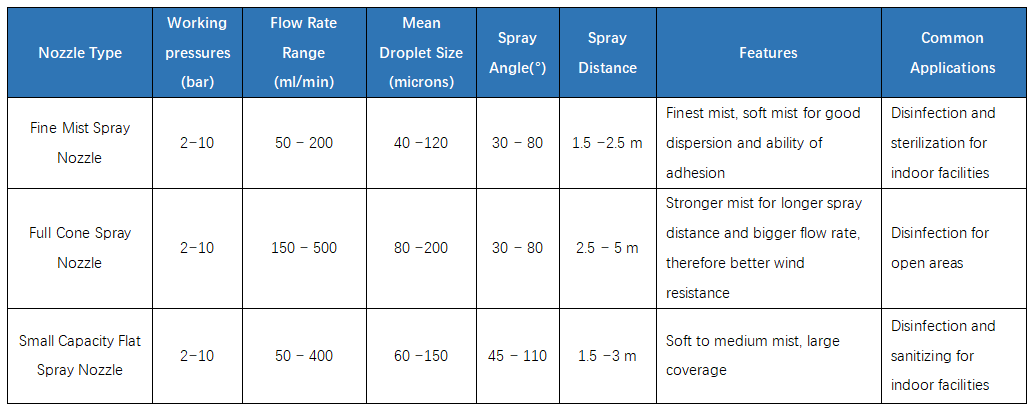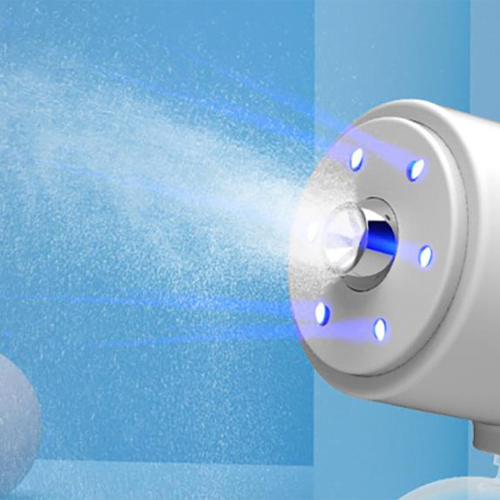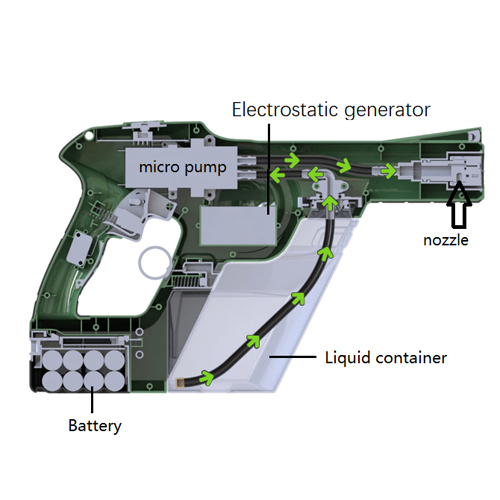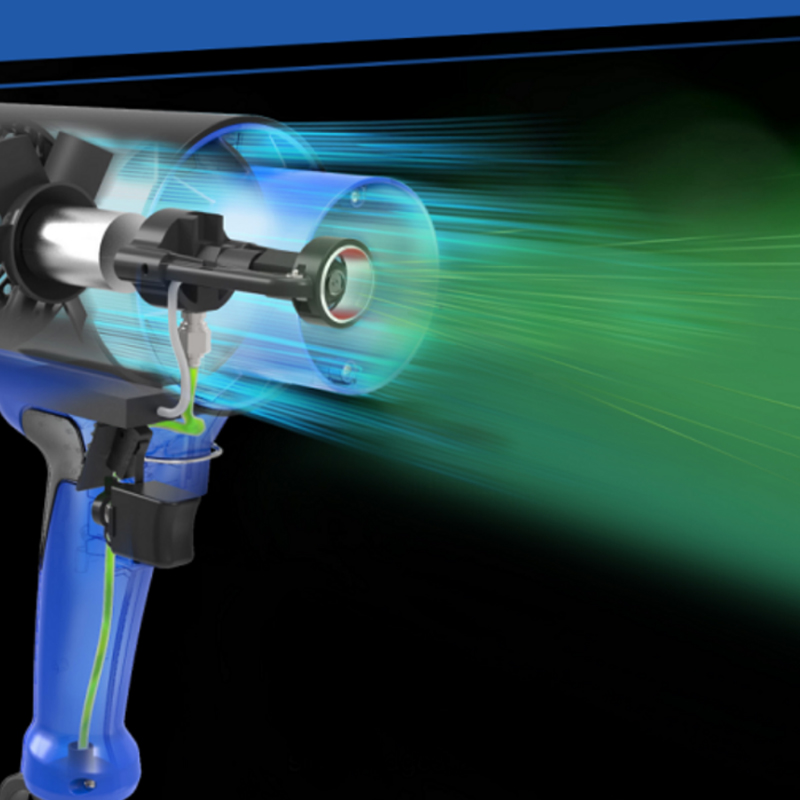Advices on Selection of Pump and Nozzle for Disinfecting Sprayer
As the outbreak and spread of novel coronavirus COVID-19 worldwide, people have realized the importance and emergency of the work of disinfection and decontamination. Disinfection sprayers as important weapons to fight the virus and bacteria now are widely used. Generally, there are several types of sprayers in the market, including low pressure single fluid sprayer, high pressure single fluid sprayer, two fluid sprayers. You can go to The Comparison of Some Popular Electrostatic Backpack Disinfecting Sprayer in Market for some information. Here we will discuss the low-pressure single fluid sprayer, which consist of micro pump, spray nozzle, electrostatic generator, water container, battery, etc. The core components are the pump, spray nozzle and electrostatic generator, which play an important role in the spray performance. The proper selection of pump and nozzle is the primary guarantee of the function of sprayers.

The atomized disinfectant would obviously increase the effect of disinfection and sterilization, including:
Diaphragm pump:
Gear pump
Decreasing self-suction and output pressures of liquid due to the wear and tear of gears for long-term running
Relatively shorter life time
We will talk about the diaphragm pump in the following since it is more often used pump in the market.
-Fine Mist Spray Nozzles:able to produce the finest mist with droplet size 40 microns to 120 microns.
-Full Cone Spray Nozzle:able to produce coarser mist with droplet size 40 microns to 120 microns.
-Small Capacity Flat Spray Nozzles:able to produce the fine to medium mist with droplet size 60 microns to 120 microns

The nozzles above are available in stainless steel or brass. Single head spray tip or multi-nozzles spray heads are optional to compatible with different usage scenarios.



From the Figure 2 and Figure 3, we can see clear the relationship of pressure-flow rate-droplet size mentioned above. Please note that the test results were obtained by standard testing device which can provide stable and enough flow and pressure supply. When using diaphragm pump, the situation is different.

Figure 4: Flow rate-pressure chart of diaphragm pump
From Figure 4, we can see the relationship of flow rate and pressure. The obviously decline in flow rates according to rising pressures. The pressures in the chart are called open pressures, which is the real working pressure for corresponding flow rate. For some datasheet of diaphragm pump, the supplier uses close pressure to indicate the maximum pressure of pump that may lead to misunderstanding.
When choosing a pump, we need consider the flow rate and pressure for both nozzle and pump. For the nozzle’s spray performance, you can check the datasheet first, then choose the pump that can cover the expected range of flow rates and pressures. The optimum working pressure of a diaphragm pump located in the middle 1/3 range, shown in chart below. The downward range can not provide adequate pressures while the upward range will shorten service life of pump for long time running.

Figure 5: Optimum working pressure of a diaphragm pump
In brief,to achieve the best working conditions of the sprayer, the selection of pump and nozzle is important. The matchiness of flow rate and pressure of pump and nozzle is the guarantee of performance of the sprayers.
We list the steps for selection of pump and nozzle as following:
Step 1. Determining the expect spray pattern and droplets according to your designing idea
Step 2. Choosing the proper model No. from the datasheet of nozzle
Step 3. Confirming the range of pressure and flow rate of selected nozzle
Step 4. Selecting the proper pump to make sure its optimum working pressures can cover the flow rate of the selected nozzle
Step 5. Doing trial tests by small batch of pump and nozzle to see the uniformity of the performance
For further questions, please do not hesitate to contact us. We are happy to assist you in this.
Principle of the Electrostatic Sprayer
Figure 1: Schematic Diagram of a Typical Hand-held Sprayer
From the diagram of the sprayer, we can see that the micron pump, powered by the battery, supply the water to nozzle through the tube to form a 3-10 bar (40-140 psi) input pressures. The disinfectant is atomized by the spray nozzle to produce very tiny droplets.The atomized disinfectant would obviously increase the effect of disinfection and sterilization, including:
- Increased specific surface area of the disinfectant, larger contact area and therefore higher disinfecting ability;
- Good dispersion effect, able to kill the virus in the air;
- The high velocity mist has good adhesion, able to disinfect the objects by passing quickly along or over;
- Increased coverage, higher disinfecting efficiency. The spray distance can be 2-5 meters.
Most Often Used Micro Pumps for Sprayers
There two mainly used micro pumps in the market for disinfecting sprayer: Diaphragm pump and gear pump.Diaphragm pump:
- Principle of diaphragm pump
- Advantages of diaphragm pump
- Disadvantages of diaphragm pump
Gear pump
- Principle of gear pump
- Advantages of gear pump
- Disadvantages of gear pump
Decreasing self-suction and output pressures of liquid due to the wear and tear of gears for long-term running
Relatively shorter life time
We will talk about the diaphragm pump in the following since it is more often used pump in the market.
Most Often Used Spray Nozzles for Sprayers
There are three mainly used types spray nozzles for disinfecting sprayers: Fine mist spray nozzles, Full cone Spray Nozzles and Small capacity Flat Spray Nozzles.-Fine Mist Spray Nozzles:able to produce the finest mist with droplet size 40 microns to 120 microns.
-Full Cone Spray Nozzle:able to produce coarser mist with droplet size 40 microns to 120 microns.
-Small Capacity Flat Spray Nozzles:able to produce the fine to medium mist with droplet size 60 microns to 120 microns

The nozzles above are available in stainless steel or brass. Single head spray tip or multi-nozzles spray heads are optional to compatible with different usage scenarios.
Advices on Selection of Pump and Nozzle
The flow rate and droplet size of a certain spray nozzle depends on the working pressures, the higher pressure, the bigger flow rate and smaller droplet size. In the other hand, the smaller open flow will lead to higher output pressures of the pump and vice versa. To know the relationship among flow rate, pressure and droplet size will help us to know the selection of pump and nozzle.Let’s take one of our misting nozzles - model No. M1 as example:

Figure 2: M1 nozzle Pressure-flow rate chart
Figure 3: M1 nozzle pressure-droplet size chart
From the Figure 2 and Figure 3, we can see clear the relationship of pressure-flow rate-droplet size mentioned above. Please note that the test results were obtained by standard testing device which can provide stable and enough flow and pressure supply. When using diaphragm pump, the situation is different.
Figure 4: Flow rate-pressure chart of diaphragm pump
From Figure 4, we can see the relationship of flow rate and pressure. The obviously decline in flow rates according to rising pressures. The pressures in the chart are called open pressures, which is the real working pressure for corresponding flow rate. For some datasheet of diaphragm pump, the supplier uses close pressure to indicate the maximum pressure of pump that may lead to misunderstanding.
When choosing a pump, we need consider the flow rate and pressure for both nozzle and pump. For the nozzle’s spray performance, you can check the datasheet first, then choose the pump that can cover the expected range of flow rates and pressures. The optimum working pressure of a diaphragm pump located in the middle 1/3 range, shown in chart below. The downward range can not provide adequate pressures while the upward range will shorten service life of pump for long time running.
Figure 5: Optimum working pressure of a diaphragm pump
In brief,to achieve the best working conditions of the sprayer, the selection of pump and nozzle is important. The matchiness of flow rate and pressure of pump and nozzle is the guarantee of performance of the sprayers.
We list the steps for selection of pump and nozzle as following:
Step 1. Determining the expect spray pattern and droplets according to your designing idea
Step 2. Choosing the proper model No. from the datasheet of nozzle
Step 3. Confirming the range of pressure and flow rate of selected nozzle
Step 4. Selecting the proper pump to make sure its optimum working pressures can cover the flow rate of the selected nozzle
Step 5. Doing trial tests by small batch of pump and nozzle to see the uniformity of the performance
For further questions, please do not hesitate to contact us. We are happy to assist you in this.






